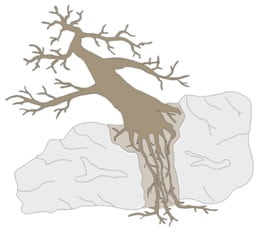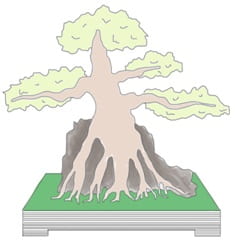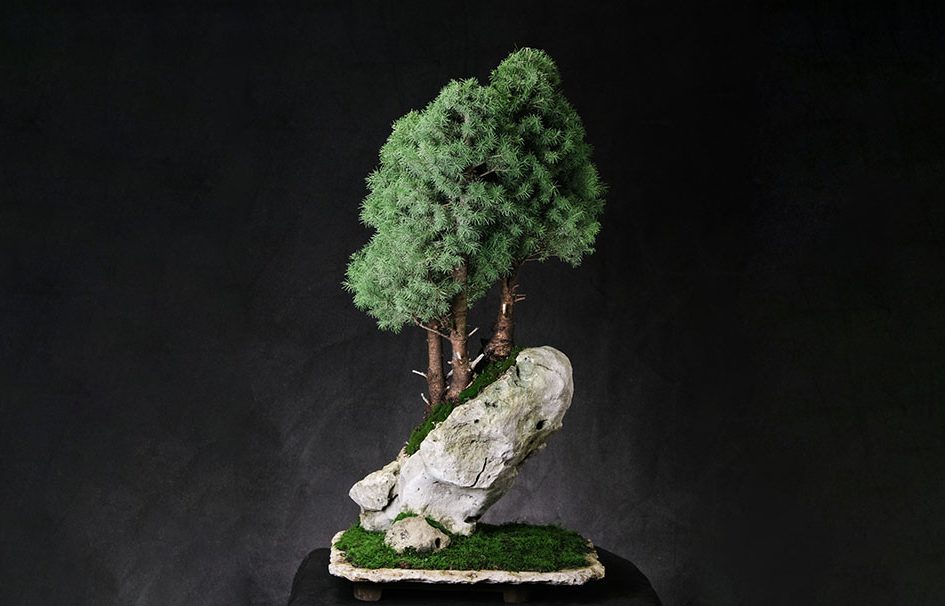The composition on stone can be divided into two different types: Ishizuki (石付) – where the roots are completely in the stone, and Sekidzijiju (石上樹) – where the plant's roots are wrapped around the outside of the stone..
As with all styles, the composition on stone must appear natural. When choosing the plant, keep in mind that the first branch should be close to the roots. In other styles, the distance of the lower branch from the roots is one-third of the plant’s height; in Ishizuki and Sekidzijiju styles, this space should be filled by the stone. The proportional relationship between the stone and the plant depends entirely on the artist’s taste. To better understand this style, it is advisable to carefully examine specimens created by experienced bonsai specialists.
The stone should have holes, scars, and depressions, showing that natural processes have had a significant impact on its formation. In short, the stone selected for this style should resemble a rock. River stones or artificially processed smooth stones are not suitable for this bonsai style.
Ishitsuki (石付)
To create this style, the stone must have a depression where soil will be added and the plant will be planted. Finding such a stone is somewhat difficult. If there is not enough space for planting the plant, we will need to manually create the depression, which is quite labor-intensive. If you notice that the plant is not securely fixed to the stone, additional holes will need to be made where copper wire will be threaded to firmly secure the plant. It is also essential to make a drainage hole in the stone. The stone should be drilled through its entire depth at the lowest point of the depression.

The stone must stand stably on the surface; if any scar on the bottom of the stone prevents it from sitting properly on the base, be sure to smooth it out. Bonsais in this style are placed in a wider, low container on the stone. The container is filled with washed sand, fine gravel, or sea pebbles. It is also possible to fill the container with water, creating a "island" impression. If the shape of the stone allows, the container may not be used for this style.
Sometimes it is impossible to create a large enough depression in the stone for normal plant growth. In this case, an additional penetrating hole is made in the stone to allow the roots to pass through.
 When transplanting, the roots are completely freed from the soil. Carefully, with the help of a small stick, pass the roots through the hole. The hole must be filled with soil. Very fine particles (it’s easier to fill small holes with dry soil), add small amounts to the hole and try to fill the void completely using the same small stick. In this case, the stone is placed in a low container filled with soil. The plant will absorb nutrients from the soil already in the container.
When transplanting, the roots are completely freed from the soil. Carefully, with the help of a small stick, pass the roots through the hole. The hole must be filled with soil. Very fine particles (it’s easier to fill small holes with dry soil), add small amounts to the hole and try to fill the void completely using the same small stick. In this case, the stone is placed in a low container filled with soil. The plant will absorb nutrients from the soil already in the container.
Seki-jiju (石 上 樹)
For this style, a plant with long roots is required. Completely free the plant’s roots from the soil and place the plant on the stone. Distribute all the large roots evenly around the stone as much as possible. It’s good if the length of the roots exceeds the height of the stone. Try to follow the grooves and scars in the stone with the roots. Then, secure the roots by wrapping them with a rope around the stone. Afterward, build a box around the stone with thin planks, which should be slightly larger than the stone. Fill the box completely with soil. Over time, the roots in this position will closely attach to the stone. After one year, in the spring, remove one-third of the wooden box. When watering, the soil will gradually wash away, revealing the roots wrapped around the stone. Another year later, remove another third of the wooden box, and after another year, completely free the plant and stone from the box. After this, place the plant in a container. For this style, it’s preferable to use a low container. When placing it in the container, ensure that the thin roots do not end up underneath the stone. Trim all the thin roots left on the surface of the soil and leave only the well-developed large roots.
 Newly emerged roots must be protected from the sun. By adding water to clay soil, it forms a dough-like mass, which is then used to cover the roots. After watering and spraying, this mass will wash away from the roots, so this procedure will need to be repeated several times during one season. After a period of time, the roots will thicken and be covered with bark.
Newly emerged roots must be protected from the sun. By adding water to clay soil, it forms a dough-like mass, which is then used to cover the roots. After watering and spraying, this mass will wash away from the roots, so this procedure will need to be repeated several times during one season. After a period of time, the roots will thicken and be covered with bark.
Unlike the Ichi-tsuki style, this style requires that the emerged
This bonsai style requires special attention during winter frosts and hot summer days. In the summer, if the plant is exposed to direct sunlight, excessive heating of the stone can cause the roots to dry out. If you cannot avoid direct sunlight, create a shade. It is also recommended to spray water on the roots and stone several times a day to cool them. After completely removing the soil, for one or two seasons, ensure the roots are wrapped during winter to prevent freezing.
For this style of bonsai, deciduous trees are recommended; for conifers, complete removal of the roots from the soil is not advisable.

